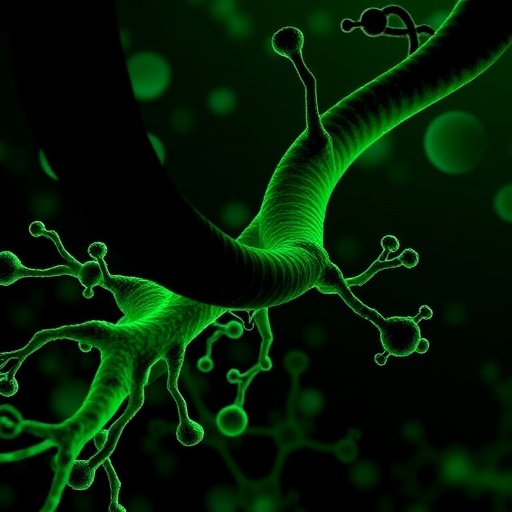In a groundbreaking study published in Genes & Immunity, researchers have unveiled a novel layer of genetic regulation critical to the intricate process of thymocyte development. The work centers on the transcriptional control of DNA Ligase IV, a pivotal enzyme involved in the repair of double-stranded DNA breaks, orchestrated through a previously uncharacterized intronic regulatory element. This discovery not only deepens our molecular understanding of T-cell maturation but also sheds light on how the precise control of DNA repair mechanisms ensures immune system integrity.
Thymocytes are the precursors to T lymphocytes, essential players in adaptive immunity that undergo rigorous selection processes in the thymus to establish a competent and self-tolerant T-cell repertoire. The process demands faithful repair of DNA breaks generated during V(D)J recombination, a complex gene rearrangement mechanism that creates diverse antigen receptors. DNA Ligase IV, part of the non-homologous end joining (NHEJ) pathway, plays a critical role in sealing these DNA breaks, thus safeguarding genomic stability during T-cell development.
Until now, the transcriptional regulation of Ligase IV within thymocytes remained largely unexplored. Estrada and colleagues employed a suite of cutting-edge molecular techniques, including chromatin immunoprecipitation sequencing (ChIP-seq), CRISPR-mediated enhancer deletions, and reporter assays, to pinpoint a functional intronic element located within the Ligase IV gene locus. This cis-regulatory element acts as a DNA “switch,” modulating gene expression in a lineage- and stage-specific manner, effectively tuning Ligase IV levels to match the developmental demands of thymocytes.
The presence of regulatory elements within introns—non-coding sections of genes traditionally regarded as “junk DNA”—has increasingly been recognized as a principal mechanism of fine-tuning gene expression. This newfound intronic enhancer represents a paradigm shift, showing that crucial genes involved in DNA repair are subject to tightly controlled transcriptional regulation at multiple genomic levels. Such regulation ensures that DNA Ligase IV is neither under-expressed, risking incomplete DNA repair, nor over-expressed, which could drive aberrant ligation and genomic instability.
Detailed analyses revealed that the activity of this intronic enhancer correlates with key stages of thymocyte maturation, including the transition from double-negative to double-positive cells, where V(D)J recombination is most active. Loss-of-function experiments implicate a direct causative link: disturbing this enhancer diminishes Ligase IV expression and compromises thymocyte viability, resulting in impaired T-cell development. These findings underscore the evolutionarily conserved necessity to coordinate DNA repair machinery with developmental checkpoints in the immune system.
Furthermore, the study uncovered dynamic interactions between the intronic enhancer and transcription factors known to govern immune cell differentiation. Transcription factors such as RUNX1 and GATA3 bind this regulatory region, facilitating context-dependent transcriptional activation of Ligase IV. This interplay highlights an intricate gene regulatory network where lineage-specific cues interface with genome maintenance pathways, balancing cellular differentiation with genome integrity.
The methodology leveraged in this research is notable for combining genome-wide profiling with precise genome editing tools, enabling the dissection of regulatory architecture in a living cellular context. By deploying CRISPR-mediated deletion of the intronic element in primary thymocyte cultures, the researchers demonstrated diminished Ligase IV transcription, impaired DNA repair, and defective thymocyte maturation, directly linking regulatory DNA function to cellular phenotypes critical for immune competence.
From a broader perspective, these findings have substantial implications not only for immunology but also for oncology and genetic disease research. DNA ligase IV deficiencies are implicated in immunodeficiency syndromes and predispose individuals to cancer. Understanding how its expression is controlled during immune cell development offers potential therapeutic avenues, including targeted modulation of enhancers to restore or fine-tune DNA repair capacity in pathological conditions.
The research also opens up exciting questions regarding the prevalence of intronic regulatory elements controlling other key DNA repair genes. This could signify a widespread molecular strategy wherein the fidelity of genome maintenance is safeguarded by layers of transcriptional control embedded deep within gene bodies, thereby linking genome regulation directly with cellular developmental programs.
Moreover, the study highlights the importance of context-specific gene regulation in ensuring developmental outcomes. By elucidating how an intronic enhancer acts as a crucial control node in the developmental trajectory of thymocytes, the work illuminates an additional layer of complexity in the immune system’s architecture—shedding light on how the genome’s non-coding regions contribute significantly to its functional output.
The findings presented by Estrada and colleagues thus mark a significant advance in our understanding of thymocyte biology and genome maintenance. They provide a blueprint for exploring intronic regulatory elements as critical DNA repair modulators, offering new avenues for immunological research and therapeutic innovation. This work demonstrates that the genome’s “dark matter” holds keys to elaborate biological processes vital for human health.
In conclusion, the identification and functional characterization of an intronic enhancer regulating Ligase IV expression usher in a new era of research into immune cell development. It reveals a finely tuned regulatory system that integrates transcriptional control with DNA repair demands, ensuring robust maturation of the immune system’s cellular arsenal. This knowledge not only enriches basic science but also lays a foundation for future interventions correcting immune deficiencies and genomic instability disorders.
As we continue to decipher the genome’s regulatory code, such discoveries underscore the importance of non-coding DNA elements in shaping cellular identity and function. The interplay revealed by this study between transcription factors, intronic enhancers, and DNA repair genes exemplifies the sophisticated molecular choreography underpinning immune system development, with wide-reaching implications for biology and medicine.
Subject of Research: Transcriptional regulation of DNA Ligase IV during thymocyte development via an intronic regulatory element.
Article Title: Transcriptional regulation of Ligase IV by an intronic regulatory element directs thymocyte development.
Article References:
Estrada, M.D., Gebhardt, C.J., Salem, M.A. et al. Transcriptional regulation of Ligase IV by an intronic regulatory element directs thymocyte development.
Genes Immun (2025). https://doi.org/10.1038/s41435-025-00353-3
Image Credits: AI Generated




